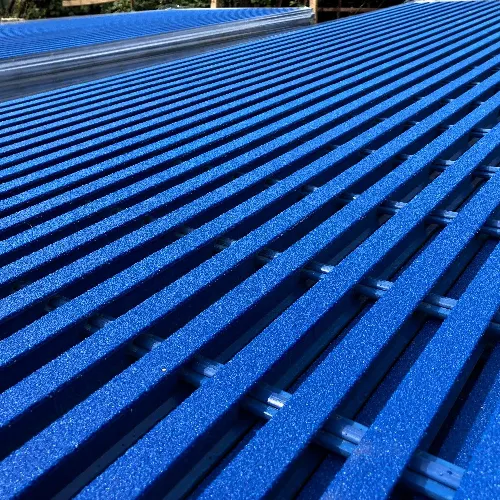loading...
- No. 9, Xingyuan South Street, Dongwaihuan Road, Zaoqiang County, Hengshui, Hebei, China
- admin@zjcomposites.com
- +86 15097380338
- Welcome to visit our website!
Innovative FRP Solutions for Durable and Eco-Friendly Walkways and Pathways
The Emergence of FRP Walkways A Sustainable and Durable Solution
In recent years, the construction and design industry has seen a significant shift towards sustainable and innovative materials. Among these materials, Fiber Reinforced Polymer (FRP) has emerged as a leading choice for various applications, particularly in the production of walkways. This article delves into the advantages and uses of FRP walkways, illustrating why they are becoming the preferred solution in many sectors.
What is FRP?
Fiber Reinforced Polymer (FRP) is a composite material made of a polymer matrix reinforced with fibers. The fibers can be made from various materials, including glass, carbon, or aramid, which provide strength and stiffness to the composite. FRP is known for its exceptional strength-to-weight ratio, corrosion resistance, and durability, making it a suitable choice for a wide range of applications, including walkways.
The Advantages of FRP Walkways
1. Lightweight and High Strength One of the most significant advantages of FRP walkways is their lightweight nature. Compared to traditional materials like concrete or steel, FRP is much lighter, which makes transportation and installation easier and less costly. Despite being lightweight, FRP walkways boast impressive strength, capable of withstanding heavy loads without deformation.
2. Corrosion Resistance Traditional materials used in walkways are often susceptible to corrosion, especially in harsh environments such as coastal areas or industrial sites. FRP’s inherent resistance to chemical and environmental degradation means that it can endure adverse conditions without deteriorating. This property extends the lifecycle of walkways significantly, reducing maintenance costs and frequency.
3. Design Flexibility The versatility of FRP allows for a wide range of design possibilities. Manufacturers can easily mold FRP into various shapes and sizes, enabling unique architectural designs that traditional materials might not accommodate. This flexibility allows engineers and architects to be more creative, resulting in aesthetically pleasing structures that blend well with their surroundings.
walkway frp

4. Sustainability As the world shifts towards more sustainable practices, FRP walkways are an eco-friendly option. The production of FRP materials often involves less energy consumption compared to traditional building materials, and their long lifespan means that they contribute less to landfill waste. Additionally, certain types of FRP can be made from recycled materials, further enhancing their sustainability profile.
5. Slip Resistance Safety is a paramount concern in walkway design. FRP surfaces can be engineered to provide excellent slip resistance, making them ideal for applications in which wet or slippery conditions are common. This feature is particularly beneficial in outdoor settings, such as parks and recreational areas, where safety for pedestrians is crucial.
Applications of FRP Walkways
FRP walkways find applications across various sectors. In industrial settings, they are commonly used for access platforms, catwalks, and storage areas, where exposure to corrosive materials is prevalent. Additionally, they are increasingly popular in marine applications, including docks and piers, due to their resistance to saltwater corrosion.
Municipal projects also benefit from FRP walkways, particularly in pedestrian pathways, bridges, and public parks. Their lightweight structure ensures easier installation in urban environments where disruption must be minimized. Moreover, their aesthetic versatility allows them to enhance the visual appeal of public spaces.
Conclusion
The advantages of Fiber Reinforced Polymer in walkway construction are clear. Its lightweight nature, high strength, corrosion resistance, design flexibility, sustainability, and safety features make it a formidable alternative to traditional materials. As industries continue to prioritize sustainability and innovation, FRP walkways are likely to become a standard choice in construction projects worldwide. With ongoing advancements in materials technology and design methodologies, the future of FRP walkways looks promising, paving the way for more resilient and aesthetically pleasing infrastructure.
In summary, embracing FRP technology not only caters to the current demands for sustainable solutions but also aligns with future goals of innovation and efficiency in construction practices.
-
Premium FRP Handrail for All ApplicationsNewsAug.29,2025
-
Low Maintenance FRP Mini Mesh Grating ProductsNewsAug.29,2025
-
Innovative FRP Square Tubes for Modern Industrial SolutionsNewsAug.29,2025
-
FRP Water Storage Tanks Wholesale Solutions for Bulk BuyersNewsAug.29,2025
-
FRP Molded Grating Solutions for Diverse Industrial ApplicationsNewsAug.29,2025
-
Construction Advancements Through FRP Pultruded ProfilesNewsAug.29,2025
-
Why Choose FRP Railings, Guardrails, and Handrail Systems?NewsAug.29,2025
